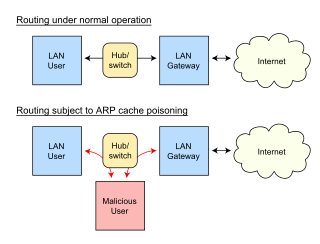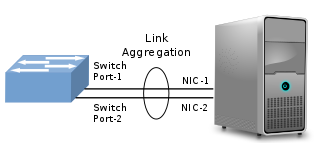The gateway address (or default gateway) is a router interface connected to the local network that sends packets out of the local network. The gateway has a physical and a logical address.
The gateway address (or default gateway) is a router interface connected to the local network that sends packets out of the local network. The gateway has a physical and a logical address.
The gateway operates at the network layer (Layer 3) of the OSI Model. The gateway is used when transmitting packets. When packets are sent over a network, the destination IP address is examined. If the destination IP is outside of the network, then the packet goes to the gateway for transmission outside of the network. The gateway is on the same network as end devices. The gateway address must have the same subnet mask as host devices. Each host on the network uses the same gateway.
The gateway should have a static address, as changing the address would cause packets not to be delivered. The gateway is typically assigned either the highest or lowest network address. This is not a requirement, but many organizations use a consistent addressing scheme to facilitate network planning.
The gateway also operates at the data link layer (Layer 2) of the OSI network model. The physical gateway address is called the media access control(MAC) address or burned in address (BIA). The physical address is assigned when the device is manufactured, and cannot be changed. When a frame is sent to a device not on the local network, the gateway's MAC address is used in the frame header.
The gateway address must be configured on each host. The network host IP interface binds the gateway address to the MAC address of the physical gateway by broadcasting IP datagrams and caching the MAC address of the reply from the gateway in an ARP table stored on the host. The gateway address may be added manually. On Windows computers, the gateway address is configured using the TCP/IP Properties.
The gateway address can be automatically determined using Dynamic Host Configuration Protocol (DHCP). DHCP allows a host to obtain network information from a server. The host contacts the server to obtain an IP address and Default Gateway address. DHCP Servers are normally provided by Internet Service Providers (ISPs).
The Dynamic Host Configuration Protocol (DHCP) is a network management protocol used on Internet Protocol (IP) networks for automatically assigning IP addresses and other communication parameters to devices connected to the network using a client–server architecture.
An Internet Protocol address is a numerical label such as 192.0.2.1 that is assigned to a device connected to a computer network that uses the Internet Protocol for communication. IP addresses serve two main functions: network interface identification, and location addressing.

A router is a networking device that forwards data packets between computer networks. Routers perform the traffic directing functions between networks and on the global Internet. Data sent through a network, such as a web page or email, is in the form of data packets. A packet is typically forwarded from one router to another router through the networks that constitute an internetwork until it reaches its destination node.

Wake-on-LAN is an Ethernet or Token Ring computer networking standard that allows a computer to be turned on or awakened from sleep mode by a network message.
The Address Resolution Protocol (ARP) is a communication protocol used for discovering the link layer address, such as a MAC address, associated with a given internet layer address, typically an IPv4 address. This mapping is a critical function in the Internet protocol suite. ARP was defined in 1982 by RFC 826, which is Internet Standard STD 37.
Proxy ARP is a technique by which a proxy server on a given network answers the Address Resolution Protocol (ARP) queries for an IP address that is not on that network. The proxy is aware of the location of the traffic's destination and offers its own MAC address as the destination. The traffic directed to the proxy address is then typically routed by the proxy to the intended destination via another interface or via a tunnel.

Network address translation (NAT) is a method of mapping an IP address space into another by modifying network address information in the IP header of packets while they are in transit across a traffic routing device. The technique was originally used to bypass the need to assign a new address to every host when a network was moved, or when the upstream Internet service provider was replaced, but could not route the network's address space. It has become a popular and essential tool in conserving global address space in the face of IPv4 address exhaustion. One Internet-routable IP address of a NAT gateway can be used for an entire private network.
A virtual local area network (VLAN) is any broadcast domain that is partitioned and isolated in a computer network at the data link layer. In this context, virtual refers to a physical object recreated and altered by additional logic, within the local area network. VLANs work by applying tags to network frames and handling these tags in networking systems –

In IEEE 802 LAN/MAN standards, the medium access control (MAC), also called media access control, is the layer that controls the hardware responsible for interaction with the wired or wireless transmission medium. The MAC sublayer and the logical link control (LLC) sublayer together make up the data link layer. The LLC provides flow control and multiplexing for the logical link, while the MAC provides flow control and multiplexing for the transmission medium.
A multilayer switch (MLS) is a computer networking device that switches on OSI layer 2 like an ordinary network switch and provides extra functions on higher OSI layers. The MLS was invented by engineers at Digital Equipment Corporation.
The Bootstrap Protocol (BOOTP) is a computer networking protocol used in Internet Protocol networks to automatically assign an IP address to network devices from a configuration server. The BOOTP was originally defined in RFC 951 published in 1985.
Zero-configuration networking (zeroconf) is a set of technologies that automatically creates a usable computer network based on the Internet Protocol Suite (TCP/IP) when computers or network peripherals are interconnected. It does not require manual operator intervention or special configuration servers. Without zeroconf, a network administrator must set up network services, such as Dynamic Host Configuration Protocol (DHCP) and Domain Name System (DNS), or configure each computer's network settings manually.

In computer networking, ARP spoofing, ARP cache poisoning, or ARP poison routing, is a technique by which an attacker sends (spoofed) Address Resolution Protocol (ARP) messages onto a local area network. Generally, the aim is to associate the attacker's MAC address with the IP address of another host, such as the default gateway, causing any traffic meant for that IP address to be sent to the attacker instead.
A default gateway is the node in a computer network using the Internet protocol suite that serves as the forwarding host (router) to other networks when no other route specification matches the destination IP address of a packet.
Networking hardware, also known as network equipment or computer networking devices, are electronic devices that are required for communication and interaction between devices on a computer network. Specifically, they mediate data transmission in a computer network. Units which are the last receiver or generate data are called hosts, end systems or data terminal equipment.

In computer networking, link aggregation is the combining of multiple network connections in parallel by any of several methods. Link aggregation increases total throughput beyond what a single connection could sustain, and provides redundancy where all but one of the physical links may fail without losing connectivity. A link aggregation group (LAG) is the combined collection of physical ports.
In computer networking, a host model is an option of designing the TCP/IP stack of a networking operating system like Microsoft Windows or Linux. When a unicast packet arrives at a host, IP must determine whether the packet is locally destined. If the IP stack is implemented with a weak host model, it accepts any locally destined packet regardless of the network interface on which the packet was received. If the IP stack is implemented with a strong host model, it only accepts locally destined packets if the destination IP address in the packet matches an IP address assigned to the network interface on which the packet was received.
A UDP Helper Address is a special router configuration used to forward broadcast network traffic from a client machine on one subnet to a server in another subnet.
In computer networking, a link-local address is a unicast network address that is valid only for communications within the subnetwork that the host is connected to. Link-local addresses are most often assigned automatically with a process known as stateless address autoconfiguration (SLAAC) or link-local address autoconfiguration, also known as automatic private IP addressing (APIPA) or auto-IP.
The link layer is the lowest layer in the TCP/IP model. It is also referred to as the network interface layer and mostly equivalent to the data link layer plus physical layer in OSI. This particular layer has several unique security vulnerabilities that can be exploited by a determined adversary.